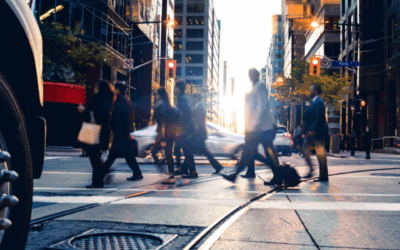In 2011, Vancouver committed to becoming the greenest city in the world by 2020. While living up to this lofty objective has proven tricky, the city recently introduced a historic by-law that will reduce GHG emissions from all new houses. It’s a big step towards achieving the targets set out in the City’s 2016 Zero Emissions Building Plan as well as its 2019 Climate Emergency Response report.
More importantly, the changes in Vancouver are building momentum. Vancouver’s new by-law brings the City closer in line with provincial and national efforts to improve the energy performance of buildings. If more governments take Vancouver’s lead, shrinking the climate footprint from our homes may be easier than we think.
Amendments to Vancouver’s Buildings By-law
Late last month, City Council approved a set of amendments to the Vancouver Buildings By-law, which aim to reduce carbon emissions from new single and multifamily homes. Key amendments include:
- Introducing additional requirements for new residential buildings of three storeys and under to be built with zero-emissions space and hot water heating (such as heat pumps);
- Lowering the cap on annual carbon emissions from large homes (those larger than 325 m2, or approximately 3,500 ft2) from three to two tonnes per year;
- Aligning building requirements with both the BC Energy Step Code and the national Energy Star initiative; and
- Revising existing requirements to ensure that new one- and two-family dwellings are outfitted with electric vehicle (EV) charging capacity (in line with requirements for multi-family buildings).
Let’s unpack what these changes mean for the City.
Climate benefits at a relatively low cost
Vancouver’s new building requirements tackle its top emission sources head on. Burning natural gas for heat and hot water is the number one source of emissions in the city (accounting for 56 percent of total emissions in 2018). Second are emissions from burning gas and diesel in vehicles, which amounted to 38 percent of Vancouver’s total emissions that same year. The latest by-law changes go straight to the source by requiring new homes to be built with zero emissions heating and by increasing access to residential charging infrastructure—a key enabler of EV uptake.
The changes are expected to have measurable impacts on Vancouver’s emissions. A report by Vancouver city staff estimates the new zero emissions space and hot water heating requirements will result in 63 percent less carbon pollution than similar homes built according to the 2019 by-law, and 86 percent less than homes built to the 2007 requirements.
What’s more, none of the proposed changes are projected to be particularly costly for homeowners, especially when compared to the potential cost of retrofitting down the road. For example, the cost impacts of the new zero emission housing requirements are expected to be, on average, less than half of one percent of the sale price for new homes. The updates are even anticipated to result in monthly cost savings for most affected homeowners and renters.
Similarly, the costs to support EV charging capacity in all new residential parking stalls are not anticipated to be significant. For reference, the City of Port Coquitlam estimated the cost of installing level 2 charging capacity at time of construction to be between $60 and $350 for single-family dwellings and between $200 and $1,150 for multi-residential dwellings (all of which are significantly lower than the costs of retrofitting to install EV capacity).
Installation costs aside, an increase in EV uptake in the city would also contribute to improved air quality. If the social costs of pollution were considered, the broader benefits of the new by-law could be substantial.
Building a wave of momentum
The amendments to Vancouver’s by-law are a big deal in their own right, but they’re also part of a broader effort in the province, and across the country, to cut emissions from buildings.
The BC Energy Step Code has already been adopted by over 60 municipalities in BC, including many surrounding Vancouver. By adding a new performance path option in line with Step 4 of the Step Code, the new by-law brings Vancouver into closer alignment with the Province and a significant number of municipalities. This in turn provides industry with more consistency across jurisdictions. And, because these new regulations provide a performance-based option, it gives builders greater design flexibility, which also helps drive innovation and lower costs.
What’s more, a number of Vancouver’s new by-law requirements align with the national Energy Star program. This alignment will help create opportunities for local producers to develop products for a national market.
The Vancouver Building By-law is an essential policy lever in the City’s toolbox. However, Vancouver City Council’s ability to adopt its own Building By-law is unique in BC and uncommon across the country. In most parts of Canada, provinces therefore play an important role in enabling cities to take these kinds of actions, just as BC has done by providing all municipalities in the province with more authority through its Energy Step Code.
Jurisdictional powers aside, Vancouver’s building by-laws can act as a blueprint for other governments that are looking to build greener communities. As more governments adopt these types of zero emissions building standards, the rising demand for low-carbon building supplies will drive down costs, making zero emissions homes more affordable and accessible.
Laying the foundation for a greener future
Reducing emissions from buildings can be difficult as they are long-lived assets with slow capital stock turnover. As a result, the actions taken today in the buildings sector have the potential to lock-in emissions well into the future. While policies targeting new buildings may see slower results than those requiring retrofits of existing stock, they represent a more cost-effective approach with potentially huge impacts in the long-term.
To be sure, Vancouver hasn’t yet topped any (arguably subjective) lists as the greenest city in the world, but it has, time and again, demonstrated strong environmental leadership, in particular in greening its buildings sector. The Zero Emissions Building Plan cemented Vancouver as one of the few global cities with a strategy for how it will make new buildings net zero by 2030, and its latest by-law amendments bring the City a step closer to achieving this goal.
You might also like…





